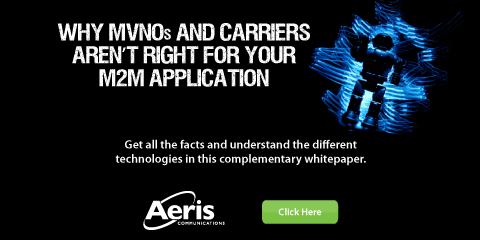Lean, Mean, Machine to Machine: Supporting New Digital Services
Lean and mean
In the realm of new digital services that are derived from M2M connectivity, support systems must deliver the most bang for the buck—peak efficiency at the lowest cost. They need to be lean and mean. This is driving innovation in billing that isn’t seen in the handset world.
“Carriers do very well on the enterprise/large company level, but where we see a lot of IoT applications going, it is really slanted towards being entrepreneurial and innovative,” said John Horn, President, RacoWireless, in an interview with Pipeline.
Aeris Communications, an M2M service provider and technology vendor, solved the support systems equation by tuning everything in its infrastructure to meet the dynamics of M2M business cases. This included developing its own billing platform on open-source code that is delivered from the cloud.
“You can’t have a system in which you’re spending so much money per end point,” Raj Kayan, CMO, Aeris Communications, told Pipeline in a recent interview. “We’ve built our own billing system…at a cost point of 1-2% of what a carrier billing system would be.”
Cycle30, a cloud billing provider, has seen a lot of traction in the M2M space. In between moderating and meetings at Digital Disruption 2013, I asked Jim Dunlap, President, Cycle30, about developments in cloud billing. He said that he was most impressed with the growth in M2M business, and that the use cases presented by M2M services fit perfectly with a lean yet powerful cloud billing platform.Nimble IoT
“For any device to work in the Internet of Things, it requires network connectivity (fixed or wireless), activation and provision, and management and monitoring, as well as a way to verify and bill for the use on the network,” wrote Jim Dunlap in April. “All of these need to be in place when you roll out a device to market—not in a matter of months or years, but literally in a matter of weeks.”
Support systems for new digital services have to be exceedingly flexible to address the widely varying use cases and business models. In some cases, such as stationary monitoring and reporting services (smart meters), data can be batch uploaded at a pre-defined time over a pre-defined period. In other cases, such as geo-fencing applications for child monitoring devices and asset tracking, real-time control and analysis of every last bit is critical to the service.
Likewise, not all data is the same, even when it originates from the same service. In connected cars, for instance, emergency response and accident reporting must take priority over infotainment. Bandwidth requirements vary greatly as well. Applications like dynamic digital signage require a fat pipe, while basic monitoring applications could get by on dial-up.
As data moves across state and national borders, regulatory requirements come into play, particularly in the case of digital services that manage healthcare or financial data. Support systems must be capable of accommodating these mandates.





















